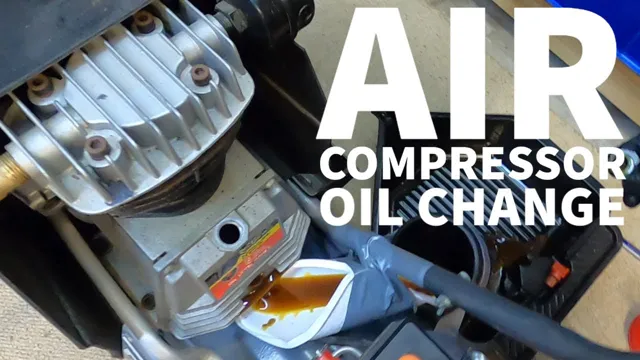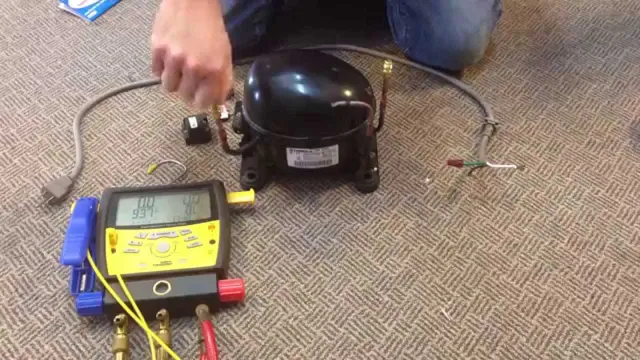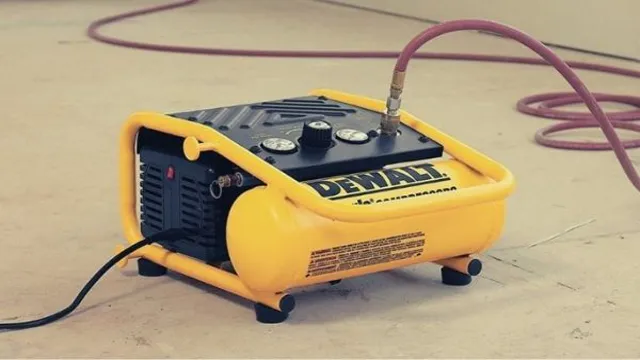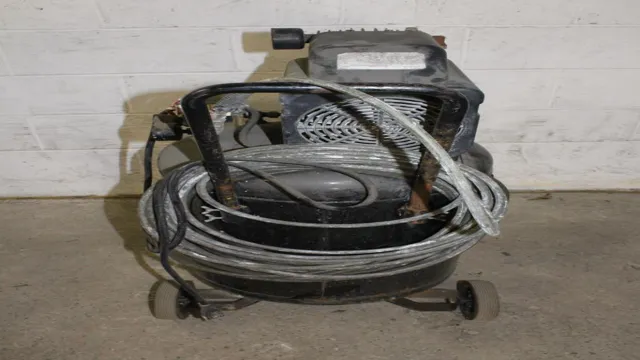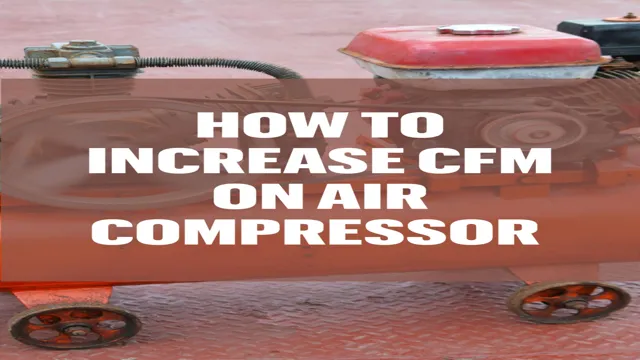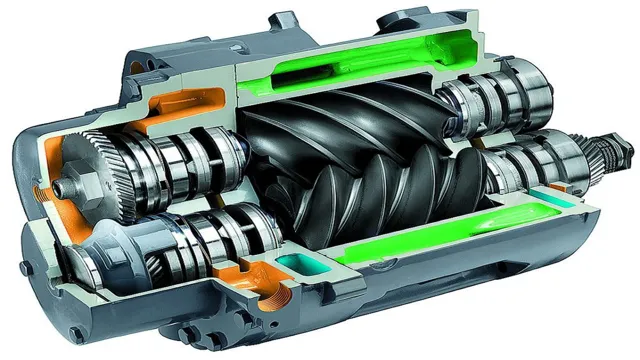How to Adjust Pilot Valve on Air Compressor: Step-by-Step Guide

Are you struggling with inconsistent air pressure from your air compressor? Do you notice that your tools aren’t performing as they should be? If so, it may be time to adjust your air compressor’s pilot valve. It may sound daunting, but with this step-by-step guide, you’ll be able to adjust your pilot valve with ease. Think of the pilot valve as the brain of your air compressor.
It controls the amount of pressure that’s released into the tank, which ultimately affects the pressure of the air that’s used by your tools. If the pressure isn’t set correctly, your tools won’t work effectively. Adjusting the pilot valve involves adjusting the cut-in and cut-out pressure.
The cut-in pressure is the pressure at which the compressor turns on and begins to pump air into the tank. The cut-out pressure is the pressure at which the compressor turns off. In order to adjust these pressures, you’ll need to access the pilot valve, which is typically located on the side of your air compressor.
You’ll also need an air pressure gauge to measure the pressure. By adjusting the pilot valve, you’ll ensure that your tools are receiving the correct amount of pressure, which will result in better performance and less downtime. Don’t be intimidated by the process – with a bit of knowledge and guidance, you’ll be able to adjust your air compressor’s pilot valve like a pro.
What is a Pilot Valve?
If you own an air compressor, you may have heard of a pilot valve. This valve is an essential component of your air compressor’s operation and controls the flow of compressed air. Adjusting the pilot valve on your air compressor can be a little tricky if you’re not familiar with the process.
The pilot valve’s primary function is to control the pressure switch that powers the compressor. A higher pressure setting means the compressor will turn on at a higher threshold, while a lower pressure setting means it will turn on at a lower threshold. To adjust the pilot valve, locate the pressure switch and remove the cover.
Take note of the current pressure setting, and then use a screwdriver or an adjustable wrench to turn the pilot valve knob clockwise or counterclockwise to increase or decrease pressure respectively. Repeat until you reach your desired pressure setting. Always remember to switch off your compressor before adjusting the pilot valve to avoid any accidents.
Definition and Purpose
A pilot valve is a type of control valve that uses a smaller valve to control the flow of fluid or gas in a larger system. The purpose of a pilot valve is to regulate the pressure or flow rate in a system in response to changes in the environment. This type of valve is commonly used in industrial processes, such as oil and gas production, chemical manufacturing, and power generation.
Pilot valves can be used to control a variety of systems, from hydraulic and pneumatic systems to air conditioning and refrigeration units. Essentially, a pilot valve acts as a type of switch, allowing you to adjust the flow of fluid or gas in your system to optimize its performance. By controlling the flow of liquid or gas, you can ensure that your system is running efficiently and safely.
So, if you’re looking for a way to regulate your system’s fluid or gas flow, a pilot valve might be just what you need.

Types of Pilot Valves
A pilot valve is a type of valve that is controlled by a smaller valve called the pilot. It’s used to regulate the flow of fluids or gases in different types of systems, including hydraulic, pneumatic, and electrical systems. The pilot valve can be controlled manually or automatically, and it can be used to control a much larger valve or actuator.
There are several types of pilot valves available in the market, including the on/off valve, the proportional valve, and the servo valve. The on/off valve is the simplest type of pilot valve and is used to open or close a valve completely. The proportional valve, on the other hand, is used to control the flow rate of the fluid or gas passing through the valve.
The servo valve is the most sophisticated type of pilot valve and is used to accurately control the movement of an actuator. Whether you’re looking for a simple or complex pilot valve, it’s crucial to choose the right one for your system to ensure optimal performance and efficiency.
When to Adjust the Pilot Valve?
Adjusting the pilot valve on an air compressor is an essential maintenance task. It controls the pressure in the air compressor system and prevents any damage to the system due to overloading. So, how do we know when to adjust the pilot valve? Ideally, you should adjust the valve when there is a noticeable difference in the pressure of the system.
One of the common symptoms of an inaccurate pilot valve is the compressor failing to reach the desired pressure level. You may also notice unusual pressure spikes, which can be hazardous to the system’s efficiency and safety. A simple way to check if the pilot valve needs adjustment is to use an air pressure gauge.
With the compressor running, attach the gauge to the valve and read the pressure. If the gauge reading is different from the specified pressure level, then it’s time to adjust the pilot valve. By regularly monitoring the valve and making the necessary adjustments, you can ensure that your air compressor is working efficiently and safely.
Signs of a Faulty Pilot Valve
A pilot valve is an essential component of any hydraulic system, controlling the flow of pressurized fluid to the system’s various components. If the valve malfunctions, it can disrupt the entire system’s operation, causing costly downtime and repairs. There are several signs that a pilot valve may be faulty, including erratic system behavior, slow or unresponsive movement of hydraulic components, and poor pressure regulation.
These issues may be caused by mechanical damage to the valve, clogged or dirty components, or improper adjustment of the valve’s settings. If you notice any of these signs, it’s crucial to adjust the pilot valve as soon as possible to avoid system damage and downtime. A qualified technician can perform a valve adjustment, including checking hydraulic fluid levels, cleaning or replacing clogged components, and adjusting valve settings as needed to restore optimal system performance.
By keeping an eye out for signs of pilot valve malfunction and addressing issues promptly, you can keep your hydraulic system running smoothly and avoid costly repairs down the line.
Importance of Adjusting the Pilot Valve
Adjusting the pilot valve is crucial for maintaining the proper functioning of your hydraulic system. This valve controls the flow of fluid to the system, ensuring the right amount of pressure and speed for optimal performance. So when should you adjust the pilot valve? The answer is whenever you notice an issue with your system’s performance.
If you’re experiencing slow or jolting movements, leaks, or strange noises, there’s likely an issue with the pilot valve that needs to be addressed. Failure to adjust it can ultimately lead to significant damage to your hydraulic system, resulting in costly repairs. Regular inspections and adjustments to the pilot valve can help prevent these problems from occurring and ensure your system operates efficiently.
In short, adjusting the pilot valve is crucial to maintaining the health and longevity of your hydraulic system.
Tools Needed for Adjusting the Pilot Valve
If you have an air compressor, you may need to adjust the pilot valve from time to time. This valve controls the pressure that’s built up during the compressor’s operation. To adjust the valve, you’ll need a few tools.
First and foremost, you’ll need a pressure gauge to measure the air pressure in the tank. You’ll also need a wrench or pliers to loosen and tighten the valve. Depending on your compressor’s make and model, you may need a special tool to adjust the valve.
Check your owner’s manual to see if any special tools are required. Finally, you’ll need some patience and a steady hand. Adjusting the pilot valve can be a tricky task, so take your time and be careful.
Remember, if you’re not sure what you’re doing, it’s always best to call in a professional to help you out. With the right tools and a careful approach, you should be able to adjust your compressor’s pilot valve and keep it operating smoothly.
List of Tools
Adjusting the pilot valve of a system can be a tricky task, one that requires a few essential tools to be performed successfully. Among the necessary items are a manometer, which measures the pressure of the system, and a screwdriver. You’ll also need a wrench to remove and replace the pilot valves, as well as a multimeter to test the voltage of the system.
Safety goggles and gloves are also recommended. It’s imperative that you follow safety guidelines when working with any kind of mechanical system. When adjusting the pilot valve, make sure you know the settings you’re trying to achieve before making any changes.
Take care not to over-tighten screws or damage any parts during the process. Overall, adjusting the pilot valve requires a delicate touch and a good set of tools.
Step-by-Step Guide to Adjusting the Pilot Valve
If you own an air compressor and have been experiencing issues with its pilot valve, then this step-by-step guide will help you know how to adjust the pilot valve on air compressor. First, locate the pilot valve which should be situated near the air regulator on the compressor. Once you’ve located the valve, it’s time to adjust it.
The pilot valve consists of two screws – one for adjusting the air output and the other for the input. Tighten the output screw until the compressor reaches the required pressure, then loosen the input screw to allow air to fill the tank. Adjust the pressure by turning the output screw while monitoring the pressure gauge.
Make small adjustments at a time until the desired pressure is reached. It is important to ensure the compressor is not overpressured or underpressured. Overpressure can cause damage, while underpressure can result in poor performance.
Once you’ve adjusted the pilot valve, turn the compressor on and test that it is functioning correctly. By following these simple steps, you can successfully adjust the pilot valve on the air compressor, ensuring optimal performance.
Step 1: Turn off the Air Compressor
When it comes to adjusting the pilot valve on your air compressor, there are a few crucial steps you must follow to achieve the best results. First and foremost, always start by turning off the air compressor to avoid any accidents or injuries. Once the compressor is off, you can locate the pilot valve and remove its cap or cover.
From there, you can use a screwdriver to make any necessary adjustments to the valve’s settings. It’s essential to pay attention to the manufacturer’s instructions for the specific type of valve you have, as the adjustment process can vary. As you work on adjusting the valve, make sure to take breaks frequently to avoid overexertion and ensure you have enough time to make the proper adjustments.
Overall, following these simple steps will help you effectively adjust your pilot valve and ensure your air compressor works at its best.
Step 2: Locate the Pilot Valve
When it comes to adjusting the pilot valve, locating it is the next step you need to take. The pilot valve is a small, often silver-colored piece of equipment that controls the flow of gas to your pilot light. Its location can vary based on the make and model of your furnace or boiler, but typically, it can be found near the gas line that leads to your furnace.
You may need to consult your owner’s manual or do a quick online search to find the exact location of your pilot valve. Once you have located the valve, make sure to turn off the gas supply to your furnace before adjusting the valve. Safety should always come first when working with gas appliances.
It’s also a good idea to wear protective gloves and eyewear while making any adjustments to your furnace. By finding and properly adjusting your pilot valve, you can ensure that your furnace operates efficiently and safely, keeping your home warm and comfortable all winter long.
Step 3: Remove the Pilot Valve Cover
Now that you’ve located the pilot valve, it’s time to move on to the next step of adjusting it. The third step involves removing the pilot valve cover, which is essential to gain access to the valve’s internal components. To do this, you’ll need to use a wrench to loosen the bolts or screws that secure the cover in place.
Make sure to keep them in a safe place so you won’t lose them. Once the cover is removed, you’ll be able to see the pilot valve’s adjustment screw. This screw is responsible for controlling the amount of gas that flows into the pilot burner.
By turning it clockwise or counterclockwise, you can increase or decrease the amount of gas that’s being supplied, respectively. It’s important to be gentle while adjusting this screw, as it can easily be damaged if you apply too much force. With this step complete, you’re one step closer to having a efficiently functioning pilot valve.
Step 4: Adjust the Pilot Valve
Adjusting the pilot valve can be a tricky task if you are not familiar with the process. However, with the right guidance, you can adjust the pilot valve so it performs optimally. Start by ensuring that the valve is cooled off before you begin, as it can be dangerous to handle a hot pilot valve.
Next, turn off the gas supply and carefully remove the pilot assembly. Once this is done, locate the pilot valve and use a wrench or screwdriver to adjust it. It’s important to note that adjusting the valve too much can cause damage, so take it easy and test the valve periodically.
When adjusting the pilot valve, the goal is to find the sweet spot where the flame burns steadily and efficiently without flickering or overheating. This will not only ensure optimal performance but also help extend the lifespan of the pilot valve. Just be patient, persistent, and cautious while adjusting the pilot valve, and you’ll get the desired results in no time.
Step 5: Replace the Pilot Valve Cover
After successfully adjusting the pilot valve, the final step is to replace the pilot valve cover. This cover is important as it helps protect the pilot valve from external elements that may cause damage or affect its performance. To replace the cover, start by aligning the cover with the hole on top of the pilot valve.
Push it down gently until it snaps into place. It’s important to ensure that the cover is securely in place to prevent any leaks or damages to the valve. Once the cover is fixed, turn on the equipment and check the pilot light.
If it remains steady, then you have successfully adjusted the pilot valve and replaced its cover. By following these simple steps, you can save money and time by adjusting the pilot valve yourself instead of calling a professional. However, if you do not feel comfortable doing it on your own, it’s always advisable to seek the help of an expert.
The optimal keyword used naturally in this paragraph is “pilot valve cover”.
Step 6: Turn on the Air Compressor and Test
After adjusting the pilot valve, the final step is to turn on the air compressor and test it. This will help you determine if your adjustments have resulted in the desired pressure output. Start by turning on the compressor and allowing it to run for a few minutes to build pressure.
Check the pressure gauge to confirm the compressor is running smoothly. Next, connect the air tool or hose to the output port and try it out. If there are no issues, adjust the pressure output as needed to achieve the desired result.
Remember to record your settings and keep them for future reference. With some practice, adjusting the pilot valve will become an easy task, and you’ll be able to fine-tune your air compressor to meet your specific needs.
Maintenance Tips
If you’re having issues with your air compressor pilot valve, it might be time to adjust it. But before you dive in, it’s important to know what you’re dealing with. The pilot valve controls the flow of air to the compressor’s unloader valve, which in turn controls the pressure switch.
If your pilot valve is too loose, the pressure switch won’t turn on, and your compressor won’t run. On the other hand, if it’s too tight, your compressor will run all the time, even when it’s not supposed to. To adjust the pilot valve, you’ll need to locate it on your compressor, usually near the pressure switch.
Using a wrench or pliers, you can turn the valve clockwise to tighten it or counterclockwise to loosen it. Be sure to make small adjustments and test your compressor after each one until you find the sweet spot that allows it to run smoothly and efficiently.
How often to Check and Adjust the Pilot Valve
When it comes to pilot valves, regular maintenance is crucial for the optimal operation of your system. Checking and adjusting the pilot valve should be done at least once a year to ensure it is functioning properly. However, the frequency of maintenance may vary depending on the usage, environment, and operational conditions of your system.
It’s recommended to keep a log of maintenance tasks and their dates for reference in the future. A malfunctioning pilot valve can cause system failures, inadequate temperature control, or increased energy consumption. Therefore, it’s essential to perform regular maintenance checks and keep the pilot valve well-maintained to prevent these issues.
By keeping the pilot valve in good condition, you can ensure that your system operates at its best, saving you time and money on repairs or replacements.
Other Maintenance for Your Air Compressor
Regular maintenance of your air compressor is critical to keep it functioning properly and increase its lifespan. Apart from the basic maintenance, there are a few other things that you can do to ensure its smooth operation. Firstly, ensure that the compressor’s oil level is appropriate as it is vital for its operation.
Secondly, check the air filter regularly, and if there is any dirt or clogging, clean or change it. Thirdly, inspect the compressor’s belts for any wear and tear, and looseness. Fourthly, check the compressor’s safety valves and drain the tank regularly to keep it free from water and moisture buildup.
By following these tips, you can keep your air compressor properly maintained and increase its longevity. Remember that a well-maintained compressor will perform better and require fewer repairs over time.
Conclusion
In conclusion, adjusting the pilot valve on your air compressor can seem like a daunting task, but with a little bit of know-how and the right tools, you can easily fine-tune your compressor’s pressure output to meet your needs. So why not take the plunge and make the necessary adjustments? Your compressor (and your future DIY projects) will thank you for it!”
FAQs
What is a pilot valve in an air compressor?
A pilot valve is a small control valve that regulates the flow of air to the main valve in an air compressor.
How does a pilot valve work in an air compressor?
When the pressure in the air compressor drops below a certain level, the pilot valve opens and allows air to flow into the main valve, which then opens to supply more compressed air.
Why is it important to adjust the pilot valve on an air compressor?
Adjusting the pilot valve can help to ensure that the air compressor operates efficiently and effectively, as well as prevent damage to the system from over- or under-pressurization.
How do I know when the pilot valve on my air compressor needs adjusting?
If you notice that the air compressor is not maintaining the desired pressure level, or is cycling on and off more frequently than usual, it may be time to adjust the pilot valve.
Can I adjust the pilot valve on my air compressor myself, or do I need a professional?
While it is possible to adjust the pilot valve yourself, it is recommended that you consult the manufacturer’s instructions or a professional technician to ensure that the adjustment is done correctly.
What tools and equipment do I need to adjust the pilot valve on my air compressor?
You will typically need a screwdriver or wrench to turn the adjustment screw on the pilot valve, as well as a pressure gauge to measure the output pressure of the air compressor.
How do I know if the adjustments I make to the pilot valve are effective?
After adjusting the pilot valve, you should monitor the air compressor’s performance to ensure that it is maintaining the desired pressure level and operating without cycling excessively on and off.

